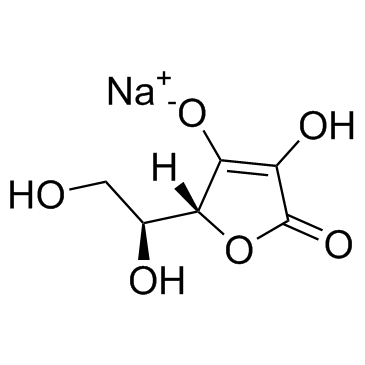sodium ascorbate

sodium ascorbate structure
|
Common Name | sodium ascorbate | ||
|---|---|---|---|---|
| CAS Number | 134-03-2 | Molecular Weight | 198.106 | |
| Density | 1.799 g/cm3 | Boiling Point | 552.7ºC at 760 mmHg | |
| Molecular Formula | C6H7NaO6 | Melting Point | 220 °C (dec.)(lit.) | |
| MSDS | Chinese USA | Flash Point | 238.2ºC | |
|
Overexpression of heme oxygenase 1 causes cognitive decline and affects pathways for tauopathy in mice.
J. Alzheimers Dis. 43(2) , 519-34, (2014) The stress protein heme oxygenase-1 (HO-1) is upregulated and co-localizes to pathological features, including tauopathies in the brains of individuals with Alzheimer's disease. However, the relationship between HO-1 and Alzheimer's disease remains unclear. I... |
|
|
Redox-based probes as tools to monitor oxidized protein tyrosine phosphatases in living cells.
Eur. J. Med. Chem. 88 , 28-33, (2014) Reversible oxidation of protein tyrosine phosphatases (PTPs) has emerged as an important regulatory mechanism whereby reactive oxygen species (ROS) inactivates the PTP and promotes phosphorylation and induction of the signaling cascade. The lack of sensitive ... |
|
|
Design, Preparation, and Characterization of Zn and Cu Metallopeptides Based On Tetradentate Aminopyridine Ligands Showing Enhanced DNA Cleavage Activity.
Inorg. Chem. 54 , 10542-58, (2015) The conjugation of redox-active complexes that can function as chemical nucleases to cationic tetrapeptides is pursued in this work in order to explore the expected synergistic effect between these two elements in DNA oxidative cleavage. Coordination complexe... |
|
|
Click modification of helical amylose by poly(l-lysine) dendrons for non-viral gene delivery.
Mater. Sci. Eng. C. Mater. Biol. Appl. 49 , 485-92, (2015) Although amylose as a naturally-occurring helical polysaccharide has been widely used for biomedical applications, few studies have dealt with its chemical modification for non-viral gene delivery. In this work, the click modification of amylose by poly(l-lys... |
|
|
Toward structured macroporous hydrogel composites: electron beam-initiated polymerization of layered cryogels.
Biomacromolecules 16(4) , 1146-56, (2015) The ability to tailor mechanical properties and architecture is crucial in creating macroporous hydrogel scaffolds for tissue engineering. In the present work, a technique for the modification of the pore size and stiffness of acrylamide-based cryogels is dem... |
|
|
Effect of electron donating groups on polyphenol-based antioxidant dendrimers.
Biochimie 111 , 125-34, (2015) Numerous studies have reported the beneficial effects of antioxidants in human diseases. Among their biological effects, a majority of antioxidants scavenge reactive radicals in the body, thereby reducing oxidative stress that is associated with the pathogene... |
|
|
ISG15 regulates RANKL-induced osteoclastogenic differentiation of RAW264 cells.
Biol. Pharm. Bull. 38(3) , 482-6, (2015) Interferon-stimulated gene 15 kDa (ISG15) is a protein upregulated by interferon-β that negatively regulates osteoclastogenesis. We investigated the role of ISG15 in receptor activator of nuclear factor-κB ligand (RANKL)-induced osteoclastogenic differentiati... |
|
|
Monoclonal antibody-functionalized multilayered particles: targeting cancer cells in the presence of protein coronas.
ACS Nano 9(3) , 2876-85, (2015) Engineered particles adsorb biomolecules (e.g., proteins) when introduced in a biological medium to form a layer called a "corona". Coronas, in particular the protein corona, play an important role in determining the surface properties of particles and their ... |
|
|
Antioxidant supplements reduced oxidative stress and stabilized liver function tests but did not reduce inflammation in a randomized controlled trial in obese children and adolescents.
J. Nutr. 144(2) , 193-201, (2014) Oxidative stress and low-grade systemic inflammation may contribute to the pathogenesis of obesity-induced comorbidities, including nonalcoholic fatty liver disease. Increasing intake of dietary antioxidants might be beneficial, but there are few data in obes... |
|
|
Mixed alkyl aryl phosphonate esters as quenched fluorescent activity-based probes for serine proteases.
Org. Biomol. Chem. 13(8) , 2293-9, (2015) Activity-based probes (ABPs) are powerful tools for the analysis of active enzyme species in whole proteomes, cells or animals. Quenched fluorescent ABPs (qABPs) can be applied for real time imaging, allowing the visualization of dynamic enzyme activation by ... |